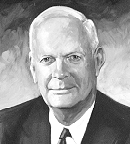Frank Bane Speech
 Frank Bane |
Excerpts from Speech by Frank Bane [Frank Bane was the Executive Director of the original Social Security Board.] |
The Social Security Act, our first organized and nation-wide security program, is designed to meet no less than five problems. It is designed to protect childhood, to provide for the handicapped, to safeguard the public health, to break the impact of unemployment, and to establish a systematic defense against dependency in old age.
Under the Act we are attacking the problem of security on all five of these fronts, and on all of them we have already made conspicuous gains. Nearly a million and a half of the needy--the aged, the blind, and dependent children--are receiving regular cash allowances under federal-state plans in 43 jurisdictions. Public health programs have been expanded and strengthened in every state in the Union. Substantially the same thing is true of maternal and child welfare services and of vocational re-education for the handicapped. A large proportion of our industrial population is covered by unemployment compensation provisions under twenty state laws. And finally, old age benefits, the initial steps completed during this past week, will go into action January 1, with about 26,000,000 workers qualifying for old age protection as a matter of right. . .
With the passage of the Social Security Act in 1935, the federal government entered into a long-time partnership with its states and their communities--a partnership for the protection of the American people. In this joint enterprise, the state takes the lead. The Social Security Act sets up a national pattern. It establishes a framework of co-operative action. It makes federal grants available. The states do the rest, co-operating with the federal government on the one hand and with their own local communities on the other. If the objectives of the Act are to be realized--actually realized in the daily lives of our people--it cannot be too strongly emphasized that the job of administration must be done by the states. The states must organize effective administrative agencies, and they must, through wider extension of the merit system, assure the selection of competent personnel in public office.
The provisions for immediate welfare programs under the Act simply give federal support to services already existing in a measure in many of our states. But though welfare laws of this sort have been on state and local books for years, financing them has brought its own troubles. As the problems of security successively outstripped the capacity of our communities and of our states, the federal government was compelled to step into the breach. All that the Social Security Act does is to recognize this fact and to place federal participation on a permanent and constructive basis.
Like unemployment, old age dependency is with us in good years as in bad. Over a million old people in this country are now actually receiving public assistance under the Act; another million are estimated to be in urgent need of assistance; and still other millions, probably up to about half of our total population over 65, are likely to come to the end of their resources long before they reach the end of their lives.
The public which demanded a social security program, the Congress which passed it, the Federal and State agencies charged with its operation intend that it shall mark a departure from the haphazard and too often pitifully inadequate welfare provisions of the past. But this is not enough. They also intend that it shall mark a concerted effort to forestall future need. In addition to its welfare provisions, the Social Security Act therefore includes two measures--those for unemployment compensation and old-age benefits-explicitly directed toward this end. It thus offers a well-rounded program for both today and the days to come.